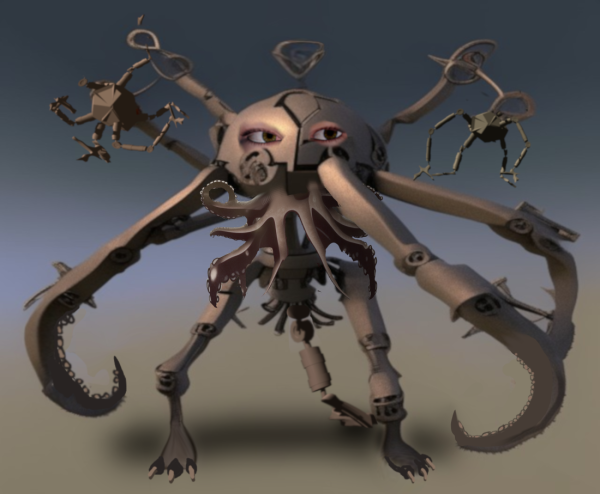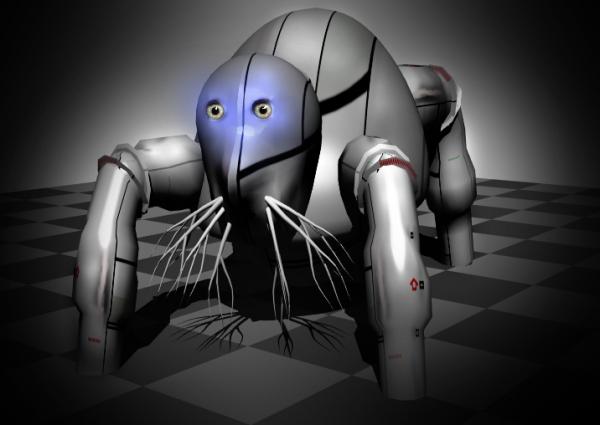BY LETTER
Cyborn, Clade
Radically altered cyborgised sophonts | |
 Image from Steve Bowers and Artbreeder | |
| Clade Cyborn are a very variable clade, thanks to their modular design and artificial shell. Some say that the eyes of a Cyborn are the only part which are recognisably biont - this is largely a myth. | |
Introduction
Over the millennia, cyborgs have long argued over what the proper balance between their biological and cybernetic aspects should be. Eventually, one answer to this question came in the form of the Cyborn, a radical movement that rejects these distinctions in favour of whatever best meets the individual's desires. Their innovations have greatly influenced how modern cyborgs manage reproduction and bodymodding, though the Cyborn themselves have diverged into so many new forms that some question whether they are really a distinct clade in their own right.
History
The first Cyborn were built by the Twin Stream branch of the Genetekkers, who were interested in using cybernetics to better adapt to the harsh environment around Jupiter. It was not yet possible to survive indefinitely in space using biotechnology alone, as the failed experiments in creating vacuum-adapted humans had shown. Volunteers suffering from serious health problems were recruited from the Beta program, while surgeons set to work integrating them with cybernetic components to a degree that had never been attempted before.
Early prototypes were ready for testing by around 540 AT, made possible by advances in nanotechnology and regenerative medicine that allowed organs to be fitted with an artificial circulatory system. This technology allowed tissues to be placed into a state of hibernation, simplifying the process of transplanting them from one body to another, as well as making revascularisation significantly easier. With these techniques, the brain and all the organs it depended on could be sustained indefinitely in a mechanical body.
Genemods carried out using retroviral therapy further altered the tissues for deeper integration with their supporting machinery, allowing the bones, muscles and nerves to grow into the systems as if they were naturally a part of the same body. Implants in the digestive tract generated power from waste products, supplemented by rechargeable batteries similar to those used by vecs at the time. With their compressed air lungs and liquid shielding under their metallic skin, these cyborgs were unprecedented in their capacity for survival in deep space.
Because their bodies were controlled directly by their nervous system rather than by DNI, the Cyborn were not crippled by the malware plagues of the Technocalypse as so many other cyborgs were. However, they were still dependent on the hi-tech industries they needed to maintain their bodies, and when these became unusable the Cyborn began to slowly die off from component failure. By the end of the Dark Age, they were all but extinct, and most of their design templates had been lost in the chaos. Only a few well prepared Hiders had survived.
It was well into the First Federation period before the Cyborn would rise again, with the invention of engenerators inspiring a new wave of interest in cybernetics. It was now possible to create biological forms that were integrated with technology from the moment of their creation, with synanotech bridging organic chemistry with diamondoid systems. Provolve and Neogenic clades across the Federation were among the first to explore the potential of this way of being, especially those who felt that their bodyplan had been poorly designed.
On Frog's Head, the new home of the Twin Stream, dissatisfaction with the Family system of governance led many to become Cyborn as a political statement, refusing to be classified by genes or ancestry. When the system was connected to the wormhole network in 2312, the introduction of early post-scarcity technologies ensured that any individual could become self-sufficient, even without the support of a Family or clan of their own. Some Cyborn now began to question whether in fact all forms of identity beyond the individual were obsolete.
From the Age of Establishment onwards, the cultural exchanges between the Cyborn of Frog's Head and their counterparts across the wider Terragen Sphere led to the creation of new societies based on anarchist principles. Unlike their Interplanetary Age predecessors, these new Cyborn could reproduce and maintain their bodies indefinitely without external support. Integrated nanoforges, mitochondrial nanomachines and processor networks enabled them to reconfigure their bodies at will, allowing endless possibilities for customisation.
These cultures remained in contact throughout the Age of Expansion, adopting modular forms with swappable components and a neurochauvinist attitude favouring biological substrates as the ideal host for one's consciousness. Since then, the clade has had both high rates of conversion, especially during major conflicts like the Version War, and high rates of attrition, most likely because those open to becoming Cyborn to begin with were just as open to other ways of life.
Physiology and appearance
A Cyborn's body is built around their 'biobox', a cybernetic shell that contains their central nervous system. This brain is integrated with an artificial scaffolding that regulates blood flow, acts as its DNI and controls the nanochondria embedded in each neuron. Other organs are built using the same principles, and can be dynamically reconfigured without the need for an autodoc. As a result, Cyborn vary greatly in appearance from one individual to the next. They are often not recognisable as cyborgs at all, instead being mistaken for neogens or bioborgs.
This flexible design allows Cyborn to use their bodies as tools for almost any given purpose. For example, the nanoforges embedded into each biobox can easily clone new organs according to any desired template, as long as the necessary raw materials are provided. The bioboxes are modular and can be combined in whatever manner suits the user, so it is not unusual for Cyborn to keep a collection of favoured limbs for different situations. These nanotech constructs are more durable and less flexible than those created by gelbots, and the Cyborn are not truly shapeshifters.
Cyborn do not restrict themselves to using Terragen biochemistry; water-ammonia, water-hydrochloric acid, methane-ethane and sulphuric acid are all commonly used as the basis for their organs. This combination of xenobiology and cybernetics has allowed the Cyborn to colonise any environment where life can thrive, not to mention enabling them to hide in places where no other bionts could survive. It is also possible to replace the entire body with artificial systems and leave the brain as the only biobox, an option preferred by many superior and nearbaseline converts.
Psychology and cognition
With the biobox system, it is possible to graft additional neural tissue onto the existing brain, which can grow to enormous size if desired. To manage this extra capacity, the DNI is capable of expanding with its host, managing the greater communications overhead and stimulating different regions to develop specialised abilities. Cyborn who take advantage of these traits can become highly capable by modosophont standards, and experimenting with different mind types has sometimes resulted in transavants and even transapients among the clade.
This mental versatility has resulted in a vast number of Cyborn subcultures, including hiders and hiveminds, exdependents and explorers, subversives and servants of the Archai. One trait that stands out is their competitive spirit, evident in the overrepresentation of Cyborn among artists, politicians, mercenaries and sports enthusiasts, many of whom have been recognised for their achievements in these fields. The emphasis on self-actualisation among the Cyborn may have contributed to this, along with the popularity of superbright and metabolic enhancements.
Mental templates for excelling at all sorts of tasks are commonly shared between Cyborn populations, and are refined and improved through extensive real-world testing. They have few qualms about using psychoware to modify their personalities, as they see their minds as a means to an end just as much as their bodies. Some Cyborn refuse to use any technology that is not part of their body, upgrading themselves into self-sufficient vehicles equipped with all the tools needed for their preferred lifestyle. Others go even further and live in total solitude to avoid dependence on others.
Society and culture
Above all else, the Cyborn are unified by a conviction that the will of the individual is the only factor that should influence how one's body and mind develop. This belief stems from experience of the long-running family feuds that marked life on Frog's Head during the Federation period, as well as the conflicts fought by the Great Houses during the Conver Wars and the Sephirotics during the Version War. For the Cyborn, ideologies are no more than a justification for power, which each sophont should claim for their own, without the hypocrisy of claiming to serve the greater good.
To this end, they encourage the questioning of all received wisdom, the critique of any values not arrived at through personal introspection, and the intimate understanding of the self made possible through DNI feedback. The body ought to reflect the uniqueness of the mind, the two being seen as a synergistic whole, with constant physical change accepted as a healthy expression of personal growth. Life is seen as a series of cycles during which different means of self-actualisation are explored, an endless process of the ego becoming its most authentic self, without ever slipping into stagnation or complacency.
Despite these beliefs, some Cyborn do embrace mainstream AI religions and philosophies like Keterism and Negentropism, as for them converting to an ideology out of one's own free will is a valid expression of the self. This remains a deeply controversial topic in Cyborn thought, and has led to accusations that they are a superficial clade united by nothing more than vanity and selfishness. Another difficult topic for Cyborn is whether or not group minds are a betrayal of one's individuality, or what individuality even means when minds can be extended across so many bodies. As the meaning of individuality is itself specific to each sophont, these debates remain unresolved.
The Cyborn in the 11th millennium
Although the Cyborn continue to attract converts to their way of life, just as many leave the clade, retaining their cultural outlook but adopting a fully biological or artificial form instead of a hybrid of the two. This has made determining their numbers more difficult than for other clades, since not even the Cyborn themselves agree on who is or isn't one of their kind. The most accepted estimate is around 280 trillion Cyborn, spread across the Fomalhaut Acquisition Society, the Mutual Progress Association, the Negentropy Alliance, the Orion Federation, the Keter Dominion, the NoCoZo and The Seams.
One challenge that the Cyborn continue to face is their tendency towards embracing extremist ideologies, with many ascended Cyborn populating the ranks of the Pure Soul Reformation, the Immanentization Crusaders and the Efficiency Maximisation Paradigm. This seems to be a result of some Cyborn taking their creed of individualism to mean that the interests of others should mean nothing compared to one's own. Debates on how to balance rational self-interest with that of society has long since replaced the old arguments over biology vs cybernetics.
 Image from Steve Bowers |
Related Articles
Appears in Topics
Development Notes
Text by Mike Parisi
Initially published on 10 November 2004.
Updated by extherian in October 2020
Initially published on 10 November 2004.
Updated by extherian in October 2020






